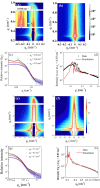Modulating phase segregation during spin-casting of fullerene-based polymer solar-cell thin films upon minor addition of a high-boiling co-solvent
- PMID: 39628884
- PMCID: PMC11611283
- DOI: 10.1107/S1600576724010082
Modulating phase segregation during spin-casting of fullerene-based polymer solar-cell thin films upon minor addition of a high-boiling co-solvent
Abstract
The impact of additives on the nanoscale structures of spin-cast polymer composite films, particularly in polymer solar cells, is a topic of significant interest. This study focuses on the blend film comprising poly(thieno[3,4-b]thio-phene-alt-benzodi-thio-phene) (PTB7) and [6,6]-phenyl-C71-butyric acid methyl ester (PC71BM), exploring how additives like 1,8-di-iodo-octane (DIO) influence the film structures spin-cast from chloro-benzene solution. Combined results of specular X-ray and neutron reflectivity, grazing-incidence small- and wide-angle X-ray scattering (GISAXS and GIWAXS), and X-ray photoelectron spectroscopy indicate that DIO could significantly enhance the dispersion of PC71BM and reduce composition inhomogeneity in the film. Time-resolved GISAXS-GIWAXS with 100 ms resolution further captures a rapid spinodal decomposition of the mixture within 1 s in the constant-evaporation stage of spin-casting. Further combined with parallel analysis of time-resolved UV-Vis reflectance, these findings reveal that DIO mitigates the spinodal decomposition process by accelerating solvent evaporation, which, in turn, decelerates phase segregation, leading to a nucleation-driven process. These observations provide mechanistic insights into the role of additives in controlling the nanostructural evolution of spin-cast films by altering the kinetics of solvent evaporation and phase separation during the spin-coating process.
Keywords: GISAXS; GIWAXS; X-ray reflectivity; additive effects; grazing-incidence small/wide-angle X-ray scattering; neutron reflectivity; polymer solar cells; spinodal decomposition.
© Kuan-Hsun Lu et al. 2024.
Figures










References
-
- Babonneau, D. (2010). J. Appl. Cryst.43, 929–936.
-
- Cahn, J. W. & Hilliard, J. E. (1958). J. Chem. Phys.28, 258–267.
-
- Cahn, J. W. & Hilliard, J. E. (1959). J. Chem. Phys.31, 688–699.
-
- Chambon, F. & Winter, H. H. (1987). J. Rheol.31, 683–697.
-
- Chen, W., Nikiforov, M. P. & Darling, S. B. (2012). Energy Environ. Sci.5, 8045–8074.
LinkOut - more resources
Full Text Sources
Miscellaneous
